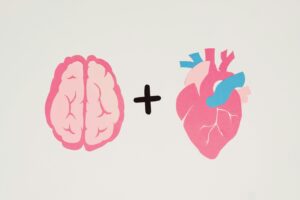The Silent Killer Hiding Behind Productivity: Chronic Stress and Burnout
You pride yourself on getting things done, crossing off items on that endless to-do list, and holding everyone else together. But at what cost? Chronic stress is breaking you down, and the very productivity you’re glorifying is eroding your health—bit by bit. Women are conditioned to push until there’s nothing left, but if you don’t stop to listen to your body’s whispers, those whispers will become screams.
Let’s break the cycle.
Why Women Are Trapped in the Productivity Cycle
From a young age, many women are taught that their worth is tied to how much they do for others. We are praised for multitasking, for “having it all,” and for sacrificing ourselves to keep things running smoothly. We internalize this, believing that rest equals laziness and asking for help is a sign of failure. Going back eight years ago, this was me, and now I have seen others do it to the point of illness.
Psychologically, this cycle is driven by:
- Perfectionism: The belief that if you don’t do it yourself, it won’t be done right.
- Fear of Judgment: Worry that others will think less of you if you take a break or set boundaries.
- Unmet Needs: Over time, this leads to resentment when help is not freely offered, even though we don’t ask clearly or consistently for it.
We end up projecting our frustration onto others. We become bitter when people fail to notice how much we’re carrying when in reality, we’ve conditioned them to believe we have everything under control.
The Whispers Your Body Is Sending You
Before chronic stress and burnout become a full-blown crisis, your body sends subtle warnings. These signs are often ignored because they don’t seem “serious enough”—until they are.
- Fatigue: That deep exhaustion no amount of sleep can cure.
- Brain Fog: Difficulty focusing, forgetfulness, and mental sluggishness.
- Irritability and Anxiety: Feeling constantly on edge or emotionally reactive.
- Digestive Issues: Bloating, discomfort, or unpredictable digestion linked to chronic stress.
- Hormonal Imbalances: Irregular cycles, increased PMS symptoms, or low libido.
- Muscle Tension and Pain: Chronic tightness in the neck, shoulders, or lower back.
Ignoring these symptoms can lead to adrenal fatigue, autoimmune issues, and long-term hormonal disruptions.
What You Can Do to Break the Cycle
Here’s where transformation begins. It’s not about adding more tasks to your plate but shifting your mindset and daily habits. There are a lot of ideas here, be sure to bookmark for later.
Find Radical Compassion for Yourself
- Acknowledge Your Efforts: Recognize that you are doing your best. You are enough.
- Rewrite the Narrative: Your worth is not tied to productivity. You deserve rest and joy, simply because you exist.
- Forgive Yourself: Stop shaming yourself for needing a break or asking for help.
Practice:
- Create a daily affirmation like, “Rest is a gift I give myself. I deserve peace and balance.”
Redefine Success
- Start each day by identifying one priority that aligns with your long-term well-being.
- Replace to-do lists with “to-be” lists—focus on how you want to feel, not what you need to accomplish.
Fuel Your Brain and Body
Stress depletes essential nutrients, so replenishing them is key to recovery.
- Adrenal Support:
- Focus on foods rich in B vitamins, magnesium, and vitamin C, such as leafy greens, avocados, and citrus fruits.
- Incorporate adaptogenic herbs like ashwagandha and rhodiola to regulate cortisol.
- Brain Fuel:
- Eat healthy fats such as omega-3s (salmon, chia seeds, walnuts) to support cognitive function. Look into mushroom supplements, ideally the fruiting body to maximize your brain health.
- Stay hydrated and avoid excess caffeine, which stresses your adrenal glands.
Create Restorative Rituals
- Morning Check-in: Spend 5-10 minutes journaling or meditating before diving into your day.
- Mid-Day Pause: Take a 5-minute break to breathe deeply and stretch.
- Evening Wind-Down: Turn off electronics an hour before bed and engage in calming activities like reading or gentle stretching.
Reconnect with Your Body
When chronic stress and burnout take over, it disconnects you from your body’s natural rhythms and instincts. Reconnection doesn’t require drastic measures—just small, mindful actions that remind your nervous system it’s safe to rest and heal.
Here are unique, actionable steps you can take today:
Anchor Yourself with a “Body Check-In Ritual”
Set a timer for three times a day (morning, midday, and evening). When the timer goes off:
- Close your eyes and take a deep breath.
- Ask yourself, “What does my body need right now?”
- Is it water? A stretch? Deep rest?
- Scan your body from head to toe. Notice any tension (jaw, shoulders, stomach, hips) and intentionally soften those areas as you exhale.
This practice cultivates awareness and builds trust between your mind and body.
Engage in 4-7-8 Breathing to Calm Your Nervous System
This simple breathwork technique coined by Dr. Andrew Weil is powerful for resetting your body’s stress response.
- Inhale deeply for 4 seconds through your nose.
- Hold the breath for 7 seconds.
- Exhale slowly through your mouth for 8 seconds.
- Repeat 3-5 times.
This practice activates the parasympathetic nervous system, signaling your body to shift out of “fight or flight” mode. It’s especially helpful during moments of overwhelm or before sleep.
Try Sensory Grounding with Nature Elements
If you’re feeling disconnected and anxious, reawaken your senses by immersing yourself in nature. If you can’t get outside, use items at home.
Steps:
- Touch natural textures: Hold a leaf, shell, or crystal. Feel its temperature and texture.
- Focus on your surroundings: Listen for distant sounds (wind, birds) and near ones (your breath).
- Smell essential oils like lavender, rosemary, or pine to evoke calming feelings.
- Visualize yourself rooted like a tree, with energy from the earth stabilizing you.
This technique helps bring you into the present moment, countering anxious thoughts.
Reclaim Your Energy with the “Release and Refill” Method
When you’re carrying stress, tension builds in your muscles, and energy gets stuck. This method involves two steps:
Step 1 – Release:
- Stand up and shake your body gently for 60 seconds. Focus on areas where tension is trapped (shoulders, neck, lower back).
- Imagine releasing the stress with each movement, like shedding heavy layers.
Step 2 – Refill:
- Place your hand on your heart. Take a slow, deep breath and say, “I am safe. I am enough.”
- Visualize filling yourself with golden light or a wave of calm energy that nourishes every cell in your body.
This exercise helps you release emotional tension and recharge your system.
Practice Intuitive Movement
Rather than forcing structured exercise, give your body permission to move how it wants to.
Steps:
- Play calming or rhythmic music.
- Let your body lead—sway, stretch, or dance freely without judgment.
- Focus on how the movement feels rather than how it looks.
This practice fosters body awareness and helps you express emotions physically, especially when words aren’t enough.
The Heart-Mind Connection Exercise

When stress keeps you in your head, this exercise helps reconnect your thoughts and emotions with your physical body.
Steps:
- Sit quietly and place one hand on your heart and the other on your stomach.
- Take 3 deep breaths and silently say, “I am here. I am listening.”
- Ask your heart, “What message do you have for me today?”
- Be patient and notice any feelings, memories, or intuitive nudges that arise.
This reflective practice helps you tap into your inner wisdom, fostering trust in yourself.
Create a Rest Ritual with Weighted Pressure
Weighted pressure on the body can help calm an overactive nervous system.
Steps:
- Use a weighted blanket or place a heavy object (like a warm towel) across your chest and shoulders while lying down.
- Focus on slow breathing and feel the sensation of pressure grounding you.
This can be deeply comforting and help reduce anxiety, especially before bed.
Stimulate Your Vagus Nerve with Cold Exposure
The vagus nerve is critical for regulating your body’s stress response. Activating it helps reduce inflammation and improve emotional resilience.
Steps:
- Splash cold water on your face for 20-30 seconds or take a cold shower rinse at the end of your shower.
- Breathe deeply through the sensation of cold to strengthen your nervous system’s recovery.
This practice trains your body to handle stress more efficiently.
Set Micro-Boundaries to Prevent Overwhelm
Many women feel disconnected from their bodies because they’re constantly overextended. Start small by setting “micro-boundaries” each day.
Examples:
- Say no to one non-essential task.
- Pause notifications on your phone for one hour.
- Take a mini-break every two hours, even if it’s just to breathe or stretch.
These small acts of self-protection build your capacity to prioritize your well-being.
Reclaim Your Sense of Play and Wonder
Chronic stress kills creativity and joy. Reconnect with your inner child by engaging in activities that spark curiosity and fun.
Ideas:
- Create art, doodle, or paint without aiming for perfection.
- Spend time stargazing or cloud-watching.
- Laugh—watch a funny video or call someone who lifts your spirits.
Play helps shift your nervous system from survival to thriving, where healing and restoration can occur.
Your body is always speaking to you, guiding you back to balance. It’s time to start listening—not with judgment, but with compassion. These practices may seem simple, but their impact is profound. Each small act of self-connection builds the foundation for deep healing and resilience.
You are not broken. You are capable of incredible transformation. ✨
Your Journey from Healing to Thriving
You’ve read this far because something inside you is ready to shift—ready to let go of survival mode and embrace a life of balance, joy, and deep connection. My Healing to Thriving Workbook is designed to guide you through that transformation.
Through gentle practices, journaling prompts, and soulful rituals, you’ll reconnect with your inner wisdom, rebuild your resilience, and nurture radical self-compassion. This isn’t about doing more—it’s about rediscovering the version of you who already has the power to thrive.
You are not alone on this journey. Healing starts with one step. ✨
Reference
Jungmann M, Vencatachellum S, Van Ryckeghem D, Vögele C. Effects of Cold Stimulation on Cardiac-Vagal Activation in Healthy Participants: Randomized Controlled Trial. JMIR Form Res. 2018 Oct 9;2(2):e10257. doi: 10.2196/10257. PMID: 30684416; PMCID: PMC6334714.




